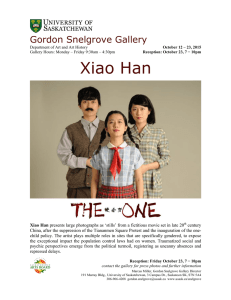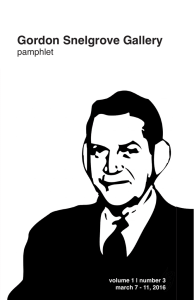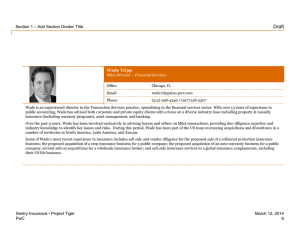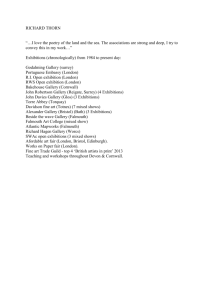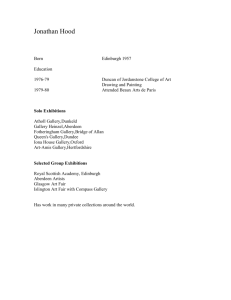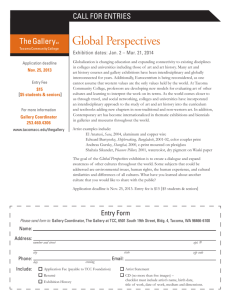Gordon Snelgrove Gallery pamphlet series volume 1 | number 1
advertisement
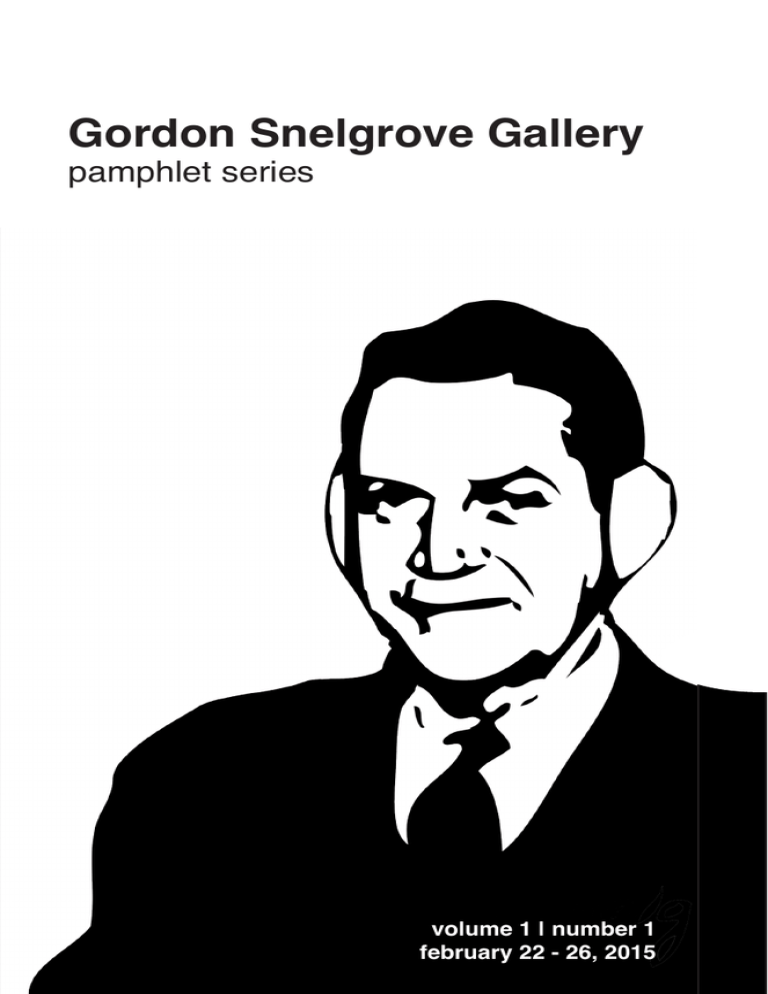
Gordon Snelgrove Gallery pamphlet series volume 1 | number 1 february 22 - 26, 2015 Gordon Snelgrove Gallery Schedule Winter/Spring 2016 volume 1 | number 1 dates artists writers February 22 – 26 Jannik Plaetner Stephanie Turtle Joshua Wade February 29 – 24 Varvara Vinogradova Patrick O’Reilly Ashley Ridley Garrison Berger March 7 – 11 Leanne Munchinsky Brianne Davis Emily Kohlert Candace Chickowski March 14 – 18 Samra Sheikh Cole Thompson Pascal Dimnik Qiming Sun March 28 – April 1 Floranne St. Amand McLaughlin Brandon Panasiuk Amy Prive Stephanie Simonot Gordon Snelgrove Gallery pamphlet series February 22 - 26, 2016 Director’s Message Marcus Miller 1 Joshua Wade - The Familiar and the Unfamiliar Jannik Plaetner - Human Topology by Stephanie Turtle 2 Director’s Message It is my pleasure to introduce this series of interpretive essays accompanying the graduating exhibitions of BFA candidates this year. Our writers reflect on the work of 17 solo exhibitions, presented over six weeks from February 22 – April 1, 2016. This is a new initiative at the University of Saskatchewan that will no doubt benefit all contributors as they enter professional life and add discursive heft to their work. I want to thank Brianne Jael Davis (B.A. Honours in Art History, 2016) in particular, who suggested the idea of a pamphlet series, worked hard to solicit writers and is one of the writers herself. Six pamphlets will be produced over six weeks and be made available to the public during the exhibitions. At the end of this cycle, photographic documentation and artist’s material will be added to a compiled catalogue and made available for a nominal cost. Marcus Miller, Director Gordon Snelgrove Gallery 1 Joshua Wade: The Familiar and Unfamiliar Jannik Plaetner: Human Topology February 22 - 26, 2016 by Stephanie Turtle Joshua Wade’s exhibition Familiar & Unfamiliar, transports the viewer towards an investigation of loosely abstracted landscapes and illusionistic architectural structures. Joshua’s work alludes to a sense of something which is recognizable, yet establishes an ambiguity by shifting scale, location, time and space to something which is not so familiar. This abstracted reality comes to life through the interplay of the dark, sharp contrasting lines in juxtaposition with the transparent layers and subtle atmospheric contours. High-contrast monochromatic tonal values combined with subtle hints of colour dominate these charcoal drawings. While scale and location become enigmatic in his work, Wade explores depth and transparency in contrast to flat planes and impenetrable space. His large drawings embrace a physicality, which reveal traces of a spontaneous process of making through experimentation by modifying and responding to the work. Wade’s prairie roots are evident for providing him inspiration and reveal his influences in landscape and abstraction. His experience working as a studio assistant for Robert Christie has inevitably led to an 2 understanding of the history of the influential Emma Lake Workshops and and the roots of Western Canadian abstract art. Wade’s interest in incorporating architectural structures comes through formal university training with artist and professor Alison Norlen. His mentorship with printmaker Nik Semenoff has also been a large influence in informing an experimental approach that is visible in his working process. In Jannik Plaetner’s exhibition the artist introduces his foundational concept: Human Topology, by combining the science of topology with nude photography. Through the use of mathematical formulas and the intersection of projected light, he abstracts the connectivity of the human form beyond a point of recognition. The details of the human body become lost and the viewer is drawn into experiencing the body through its topological equivalent. The topological shapes are the focus and become independent objects within themselves in these large scale works. The projected shapes coalesce with the various body positions by using high-contrast, monochromatic tonal values, which results in a playful exploration of chance and abstraction. Plaetner’s artistic influences are historically referenced in the field of photography through the experimental use of light on the nude form. French photographer Lucien Clergue relied predominately on natural light streaming through blinds. Another artist of interest of his is German photographer Heinrich Heidersberger, 3 who in the 1940’s worked with nudes and geometrical shapes. Plaetner acknowledges the photographic tradition with the use of black and white prints and his experimental approach to light projection on the nude form. He incorporates these traditional techniques, yet transforms them into something new through the application of topology and the utilization of recent technological advances of digital photography. Joshua Wade’s Familiar & Unfamiliar and Jannik Plaetner’s Human Topology exhibitions complement each other in the gallery and incorporate similar themes in their conversation with one another. These bodies of work relate in their large scale abstractions and their use of high-contrast, monochromatic palettes. Both artists also employ an experimental creative process which embraces the opportunity for chance, allowing auspicious moments to occur within their work. Reality becomes vulnerable, ambiguous and blurred in order to transport the viewer, through their utilization of abstract form. Although different mediums and techniques are employed by the two artists, there is a cohesiveness in their exhibitions that compliment the work of the other. 4 Gordon Snelgrove Gallery Department of Art & Art History University of Saskatchewan 191 Murray Building 3 Campus Drive Saskatoon SK S7N 5A4 306-966-4208 www.usask.ca/snelgrove snelgrovegallery@gmail.com twitter: @gordonsnelgrove instagram: @snelgrovegallery
